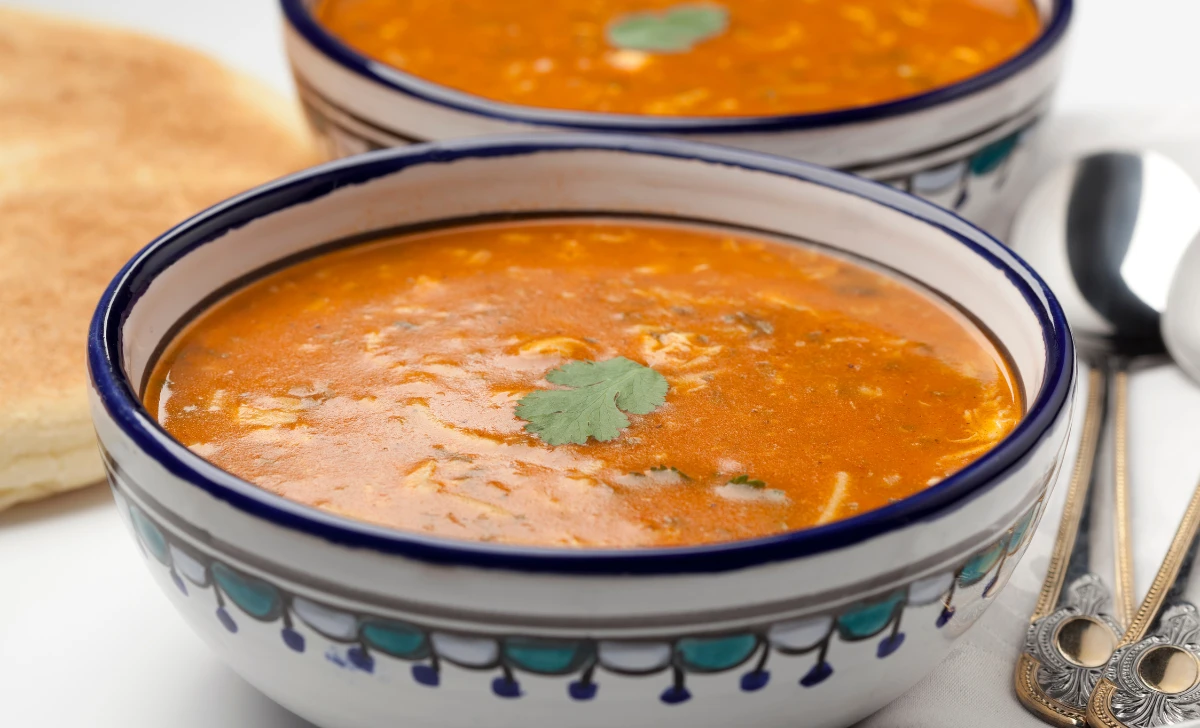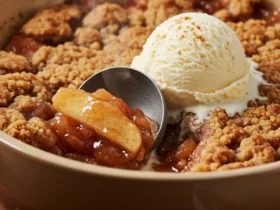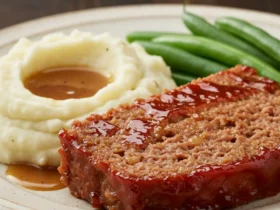Hey there, foodies! Today, we’re diving into the flavorful world of Moroccan cuisine to explore one of its most cherished dishes – Moroccan Harira. This hearty and aromatic soup has been a beloved part of Moroccan culture for centuries. Whether you’re a seasoned chef or a curious home cook, this article will guide you through the steps of preparing this delicious bowl of comfort. So, let’s grab our aprons and get ready to immerse ourselves in the magical flavors of North Africa!
[ez-toc]
History
Moroccan Harira is a traditional soup that hails from the vibrant and diverse country of Morocco, situated in North Africa. This flavorful delight is a staple during the holy month of Ramadan, where it is consumed to break the fast at sunset. However, its popularity extends far beyond the Ramadan season, as it graces the tables of Moroccan families year-round.
Cultural Significance
The history of Moroccan Harira is deeply intertwined with Moroccan culture and traditions. It is not just a dish but a symbol of togetherness and warmth shared among family and friends. In Moroccan households, the preparation of Harira often becomes a communal affair, with different family members coming together to contribute their expertise and love.
This soup is not just nourishing for the body; it also holds immense spiritual significance during Ramadan. After a day of fasting, sipping on a steaming bowl of Harira helps restore energy and provides a sense of comfort and satisfaction. It’s a beautiful representation of how food can be a means of connecting with one’s roots and spirituality.
A Culinary Adventure
Moroccan cuisine itself is a captivating fusion of flavors, influenced by Berber, Arab, and Mediterranean culinary traditions. The rich history of Morocco as a melting pot of cultures is mirrored in the diverse ingredients that find their way into Harira. The soup’s journey over the centuries has seen various adaptations and additions, making it an ever-evolving masterpiece.
Time
| Step | Time (Approx.) |
|---|---|
| 1. Soaking Chickpeas and Lentils | 8 hours |
| 2. Preparing Meat and Chopping Onions | 20 minutes |
| 3. Sautéing Onions and Meat | 10 minutes |
| 4. Adding Spices and Tomatoes | 5 minutes |
| 5. Simmering the Soup | 30 minutes |
| 6. Preparing Flour Mixture | 10 minutes |
| 7. Thickening the Soup | 15 minutes |
| 8. Adding Cooked Chickpeas and Lentils | 5 minutes |
| 9. Enhancing with Fresh Herbs | 5 minutes |
| 10. Final Seasoning and Adjustments | 5 minutes |
| Total Cooking and Preparation Time | ~ 1 hour 45 minutes |
Please note that cooking times may vary depending on individual stovetops and cooking methods.
Ingredients
| Ingredients | Quantity for 2 servings |
|---|---|
| Dried Chickpeas | 1/4 cup |
| Dried Lentils | 1/4 cup |
| Lamb or Beef, cubed | 200 grams |
| Onion, finely chopped | 1 medium-sized |
| Canned Tomatoes, crushed | 1 cup |
| Tomato Paste | 1 tablespoon |
| Celery Stalks, chopped | 2 |
| Carrots, diced | 2 medium-sized |
| Red Bell Pepper, diced | 1 small-sized |
| Fresh Parsley, chopped | 2 tablespoons |
| Fresh Cilantro, chopped | 2 tablespoons |
| Fresh Lemon Juice | 2 tablespoons |
| Olive Oil | 2 tablespoons |
| Ground Ginger | 1/2 teaspoon |
| Ground Cumin | 1/2 teaspoon |
| Ground Turmeric | 1/2 teaspoon |
| Ground Cinnamon | 1/4 teaspoon |
| Ground Paprika | 1/4 teaspoon |
| Ground Black Pepper | 1/4 teaspoon |
| Ground Cayenne Pepper | 1/4 teaspoon |
| Salt | To taste |
| Water | 4 cups |
Please adjust the quantities as per your taste preferences and dietary requirements. Enjoy your delicious Moroccan Harira!
Directions
1. Soaking Chickpeas and Lentils
- Ingredients Needed: Dried Chickpeas (1/4 cup) and Dried Lentils (1/4 cup).
- Directions:
- Rinse the dried chickpeas and lentils under cold water to remove any impurities.
- Place them in separate bowls and cover each with water. Allow them to soak for about 8 hours or overnight.
- After soaking, drain and rinse the chickpeas and lentils again before using.
2. Preparing Meat and Chopping Onions
- Ingredients Needed: Lamb or Beef, cubed (200 grams) and Onion, finely chopped (1 medium-sized).
- Directions:
- In a medium-sized pot, heat a tablespoon of olive oil over medium heat.
- Add the chopped onions and sauté until they become translucent and lightly golden.
- Add the cubed lamb or beef to the pot and cook until it browns evenly.
3. Sautéing Onions and Meat
- Ingredients Needed: Sautéed Onions and Cooked Meat.
- Directions:
- Add the chopped celery, diced carrots, and red bell pepper to the pot with the sautéed onions and meat.
- Continue to cook for a few more minutes until the vegetables begin to soften.
4. Adding Spices and Tomatoes
- Ingredients Needed: Canned Tomatoes, crushed (1 cup) and Tomato Paste (1 tablespoon).
- Spices Needed: Ground Ginger (1/2 teaspoon), Ground Cumin (1/2 teaspoon), Ground Turmeric (1/2 teaspoon), Ground Cinnamon (1/4 teaspoon), Ground Paprika (1/4 teaspoon), Ground Black Pepper (1/4 teaspoon), Ground Cayenne Pepper (1/4 teaspoon), and Salt (to taste).
- Directions:
- Stir in the crushed tomatoes and tomato paste to the pot, combining them with the cooked meat and vegetables.
- Sprinkle in all the aromatic spices – ground ginger, ground cumin, ground turmeric, ground cinnamon, ground paprika, ground black pepper, ground cayenne pepper, and salt to taste.
- Mix everything thoroughly to ensure the flavors are evenly distributed.
5. Simmering the Soup
- Ingredients Needed: Water (4 cups).
- Directions:
- Pour 4 cups of water into the pot, covering all the ingredients.
- Bring the mixture to a boil, then reduce the heat to low and let the soup simmer for approximately 30 minutes.
- The soup will gradually thicken and develop a rich aroma.
6. Preparing Flour Mixture
- Ingredients Needed: All-Purpose Flour (3 tablespoons) and Water (1/2 cup).
- Directions:
- In a separate bowl, whisk together the all-purpose flour and 1/2 cup of water until you get a smooth, lump-free mixture.
7. Thickening the Soup
- Ingredients Needed: Flour Mixture.
- Directions:
- Slowly pour the prepared flour mixture into the simmering soup while stirring continuously.
- This will help thicken the Harira and give it a smooth, velvety texture.
8. Adding Cooked Chickpeas and Lentils
- Ingredients Needed: Soaked and Cooked Chickpeas and Lentils.
- Directions:
- Add the soaked and cooked chickpeas and lentils to the pot, incorporating them into the soup.
9. Enhancing with Fresh Herbs
- Ingredients Needed: Fresh Parsley, chopped (2 tablespoons) and Fresh Cilantro, chopped (2 tablespoons).
- Directions:
- Stir in the freshly chopped parsley and cilantro, infusing the Harira with their delightful herbal notes.
10. Final Seasoning and Adjustments
- Ingredients Needed: Fresh Lemon Juice (2 tablespoons) and Salt (to taste).
- Directions:
- Squeeze the fresh lemon juice into the soup, balancing the flavors and adding a hint of zest.
- Taste the Harira and make any final adjustments to the seasoning, ensuring it suits your palate perfectly.
Serving Your Moroccan Harira
- Ladle the piping-hot Moroccan Harira into bowls, garnish with some additional fresh herbs if desired, and serve with love.
Enjoy this heartwarming and flavorsome Moroccan Harira with your loved ones, and let it transport you to the vibrant streets of Morocco. This cherished recipe is sure to become a favorite in your household as well.
Bon appétit!
Equipment Required
Nutrition Information
| Nutrition Information | Amount per 2-Person Serving |
|---|---|
| Serving Size | 1 bowl (approximately 2 cups) |
| Calories | 400 – 450 kcal |
| Total Fat | 15 – 20g |
| – Saturated Fat | 5 – 7g |
| – Trans Fat | 0g |
| Cholesterol | 40 – 50mg |
| Sodium | 600 – 700mg |
| Total Carbohydrates | 50 – 60g |
| – Dietary Fiber | 12 – 15g |
| – Sugars | 10 – 12g |
| Protein | 20 – 25g |
| Vitamin D | 0mcg |
| Calcium | 80 – 100mg |
| Iron | 4 – 6mg |
| Potassium | 600 – 700mg |
| Vitamin A | 1000 – 1200 IU |
| Vitamin C | 15 – 20mg |
Please note that the nutritional values are approximate and can vary based on specific ingredients used and portion sizes. Always check the labels on the products you use for precise nutritional information, especially if you have dietary restrictions or are following a specific diet plan. Enjoy your delicious and nourishing Moroccan Harira!
Tips
- Soaking the Legumes: For a creamier texture, soak the chickpeas and lentils for the suggested 8 hours or even longer. If you’re short on time, you can use canned chickpeas and pre-cooked lentils, but the soaked ones offer a more authentic taste.
- Choose Tender Cuts of Meat: Opt for tender cuts of lamb or beef to ensure they cook well during the simmering process and become beautifully tender in the soup.
- Spice Levels: Adjust the spices according to your preference. If you prefer a milder flavor, reduce the amount of cayenne pepper, and for a spicier kick, increase it slightly. Experiment to find the perfect balance for your taste buds.
- Vegetarian Option: For a vegetarian version, omit the meat and use vegetable broth instead of water. The soup will still be incredibly flavorful with the array of spices and vegetables.
- Simmering Time: Let the soup simmer long enough to allow the flavors to meld together. This helps create a rich and aromatic broth. However, avoid overcooking, as it may lead to the vegetables becoming too soft.
- Thickening Agent: If you prefer a gluten-free option, you can replace the all-purpose flour with cornstarch or arrowroot powder as a thickening agent.
- Herbs and Lemon: Don’t skip the fresh herbs and lemon juice. They bring brightness and freshness to the soup, elevating the overall taste.
- Make it in Advance: Like many soups, Harira tastes even better the next day after the flavors have had time to meld. Consider making it in advance and reheating before serving.
Pros & Cons
| Pros | Cons |
|---|---|
| ✅ Bursting with Flavor | ❌ Lengthy Prep Time |
| ✅ Nutritious and Filling | ❌ Requires Soaking Legumes |
| ✅ Perfect for All Seasons | ❌ Not Suitable for Vegans |
| ✅ Represents Moroccan Culture and Tradition | ❌ High Sodium Content |
| ✅ Easily Customizable | ❌ Contains Animal Fat |
Conclusion
In conclusion, the Moroccan Harira recipe is a true gem from the rich culinary heritage of North Africa. Bursting with a harmonious blend of aromatic spices, tender meats, and wholesome legumes, this hearty soup embodies the essence of Moroccan culture and traditions. Beyond being a delightful comfort food, Harira carries with it a profound spiritual significance, making it a cherished part of the Ramadan celebrations.
As you prepare this flavorsome dish, you’ll embark on a culinary adventure that will take your taste buds on a delightful journey through the vibrant streets of Morocco. The simmering aromas and colorful medley of ingredients will ignite your senses and transport you to a world of warmth and togetherness.
While the preparation may require some time and patience, the end result is well worth the effort. Each spoonful of Harira delivers a harmonious balance of textures and flavors that will leave you craving for more. Plus, with its versatility, you can adapt the recipe to suit your preferences and dietary needs, making it a perfect choice for gatherings and family dinners.
So why not don your apron and immerse yourself in the world of Moroccan Harira? Whether you’re a seasoned chef or a curious home cook, this recipe invites you to explore the cultural richness and gastronomic delights of North Africa. Gather your loved ones, create fond memories, and savor the joy of sharing a delicious bowl of Moroccan Harira together.
Give it a try, and you’ll discover why this cherished soup has been beloved by generations. Embrace the flavors, embrace the culture, and let the magic of Moroccan Harira warm your heart and soul.
Bon appétit and happy cooking! 🍲✨
Facts
- 1. The Soup of a Thousand Flavors! 🌶️🧄🍅
- Moroccan Harira is known as the “Soup of a Thousand Flavors” due to its delightful blend of spices. The recipe typically includes over ten different spices, such as ground ginger, cumin, cinnamon, and paprika, creating a symphony of tastes that dance on your taste buds.
- 2. Harira’s Hidden Ingredient – The Saharan Sand! 🏜️🌪️
- Legend has it that the traditional Moroccan Harira recipe was influenced by the Saharan desert’s sandstorms. The reddish color and unique texture of the soup were said to be inspired by the sand, making Harira not only a culinary masterpiece but also a tribute to the desert’s allure.
- 3. A “Secret” Family Recipe No More! 🤫📜
- For generations, Harira was often considered a well-kept secret, passed down from one family member to another. However, as Moroccan cuisine gained international popularity, the secret recipe was shared with the world, turning it into a beloved dish enjoyed by food enthusiasts worldwide.
- 4. Harira – The Healer’s Delight! 🌡️💊
- In Morocco, Harira is not just a tasty treat but also a cherished remedy for colds and fatigue. The soup’s nutritious blend of legumes, herbs, and spices is believed to provide nourishment and healing, making it a go-to choice during times of illness or recovery.
- 5. The Culinary Marathon – Making Harira for a Month! 🏃♀️🗓️
- Each year, during the holy month of Ramadan, some Moroccan families take on the Harira-making challenge. They cook an enormous batch at the beginning of the month and freeze it in portions, ensuring a hearty and comforting meal every day throughout Ramadan, without the daily cooking hustle.
FAQ’s
Can I make Moroccan Harira ahead of time and store it for later?
Absolutely! Moroccan Harira tastes even better when prepared in advance. Store it in an airtight container in the refrigerator for up to 3 days. Reheat gently on the stovetop, adding a splash of water if needed, before serving.
Can I freeze leftover Harira for future meals?
Yes, you can freeze Harira for up to 3 months. Allow it to cool completely before transferring it to freezer-safe containers or resealable bags. Thaw it overnight in the refrigerator and reheat on the stovetop when ready to enjoy.
Is Harira a gluten-free dish?
The traditional Harira recipe contains all-purpose flour to thicken the soup. If you require a gluten-free version, you can substitute the flour with cornstarch or arrowroot powder as a thickening agent.
Can I make a vegetarian version of Moroccan Harira?
Absolutely! To make it vegetarian, skip the meat and use vegetable broth instead of water. The soup will still be packed with flavor from the spices and vegetables.
How do I adjust the spiciness level of Harira to suit my taste?
You can easily adjust the spiciness by varying the amount of cayenne pepper. For milder flavors, use less; for a spicier kick, increase it slightly. Feel free to experiment with the spice levels to suit your palate.
Can I use canned chickpeas and lentils instead of dried ones?
Yes, you can use canned chickpeas and lentils to save time. Rinse and drain them before adding them to the soup. However, soaking dried legumes overnight provides a more authentic taste and texture.
Are there any vegan substitutions for Moroccan Harira?
Absolutely! For a vegan version, skip the meat and use vegetable broth. Replace animal fat with olive oil or vegetable oil. The soup will remain wonderfully flavorful and satisfying.
Can I add other vegetables to the Harira?
Absolutely! Feel free to get creative and add your favorite vegetables like zucchini, sweet potatoes, or spinach. Just be mindful of their cooking times and adjust accordingly.
How do I ensure the meat becomes tender during cooking?
To ensure tender meat, use cuts like lamb shoulder or beef chuck. Allow it to simmer slowly on low heat, and the meat will become beautifully tender as it absorbs the flavors of the soup.
Can I serve Moroccan Harira with any side dishes?
Yes, Moroccan Harira pairs well with a variety of side dishes. It complements crusty bread, traditional Moroccan flatbread (khobz), or even a refreshing side salad. Experiment with different options to find your perfect combination.












Leave a Review